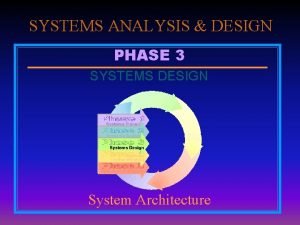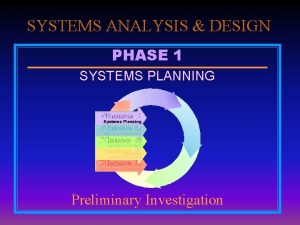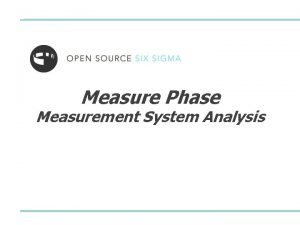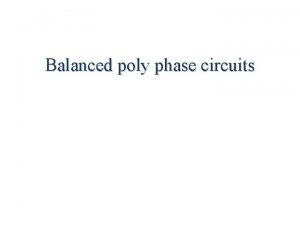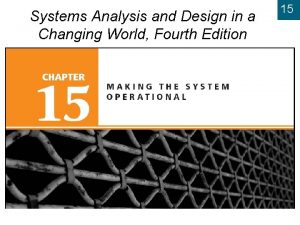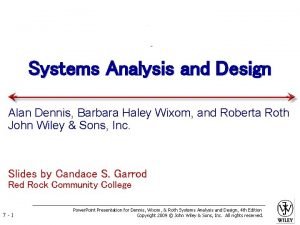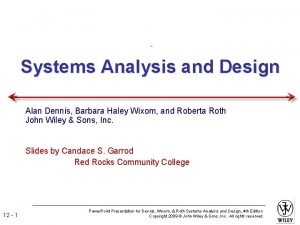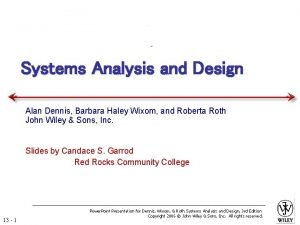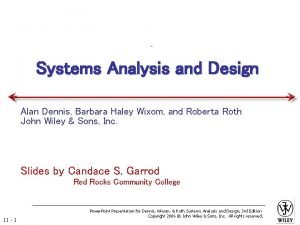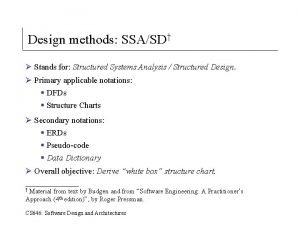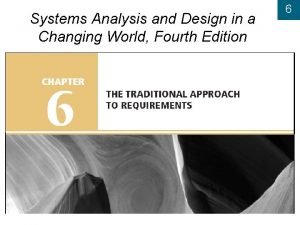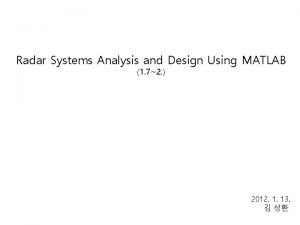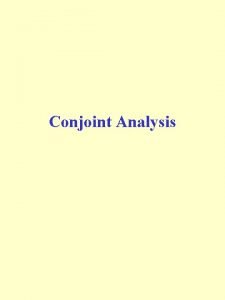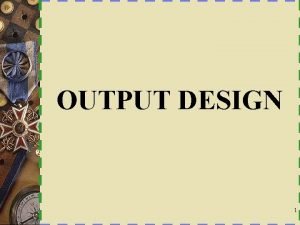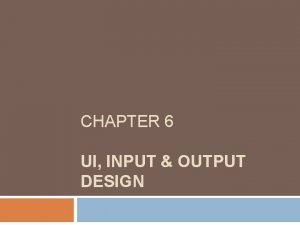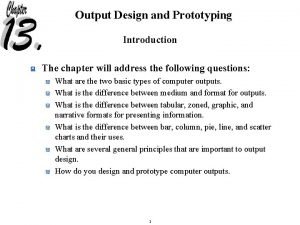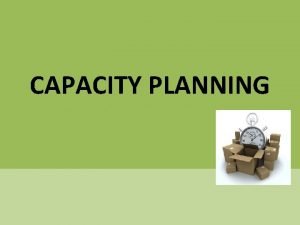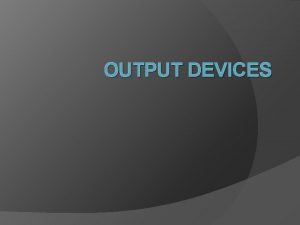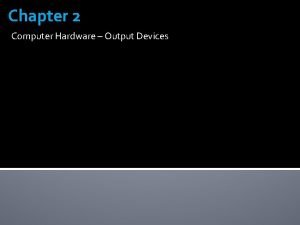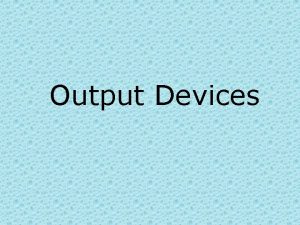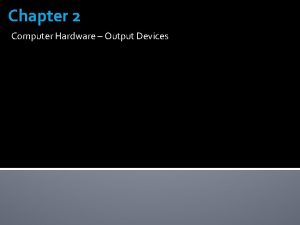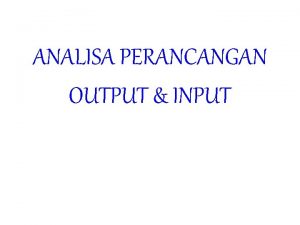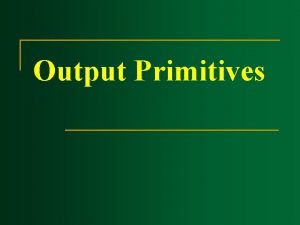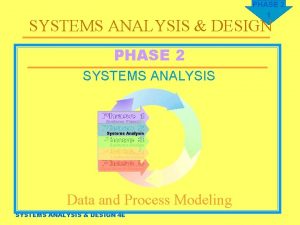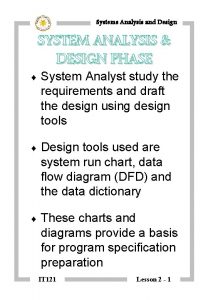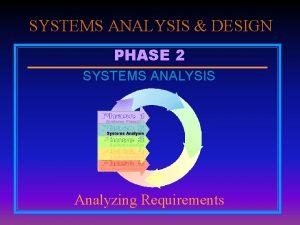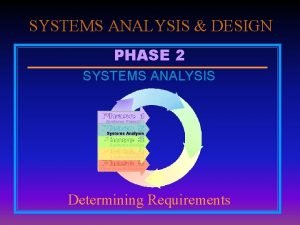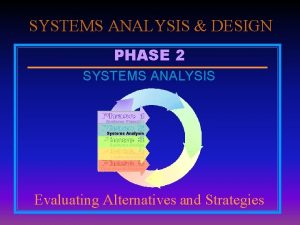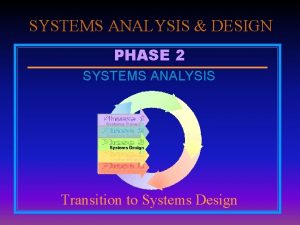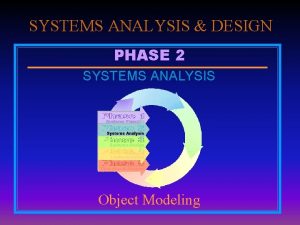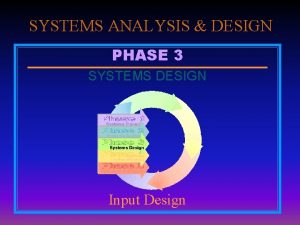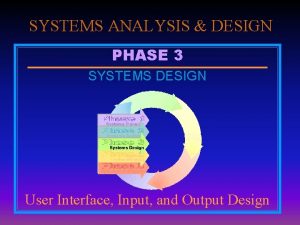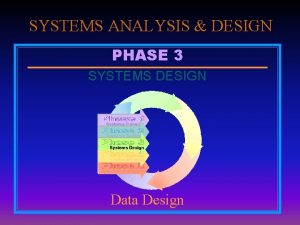SYSTEMS ANALYSIS DESIGN PHASE 3 SYSTEMS DESIGN Output













































































- Slides: 77

SYSTEMS ANALYSIS & DESIGN PHASE 3 SYSTEMS DESIGN Output Design

SDLC Phases Phase 3: Systems Design SYSTEMS ANALYSIS & DESIGN 3 E PHASE 3 2

SDLC Phases PHASE 3 3 Phase 3: Systems Design à Objectives à Review general design requirements à Complete output design, input design, file and database design, and system architecture SYSTEMS ANALYSIS & DESIGN 3 E

Chapter 6 Output Design SYSTEMS ANALYSIS & DESIGN 3 E PHASE 3 4

Objectives PHASE 3 5 à Explain the differences between logical and physical design à Discuss the objectives of systems design and provide guidelines for good design à List and describe the major activities of the systems design phase à Design and use appropriate codes in systems design and development SYSTEMS ANALYSIS & DESIGN 3 E

Objectives PHASE 3 6 à Provide examples of types of output, including new technology-based methods of information delivery à Describe the classifications of output reports and explain the differences among them à Design effective printed reports that will meet user requirements SYSTEMS ANALYSIS & DESIGN 3 E

Objectives PHASE 3 7 à Design screen reports that are easy to understand use à Explain output control concepts and methods SYSTEMS ANALYSIS & DESIGN 3 E

Introduction PHASE 3 8 à Output design is the first of four chapters covering the systems design phase of the SDLC à Chapter topics à Overview of systems design à Specific tasks in output design à Output control and automated design tools SYSTEMS ANALYSIS & DESIGN 3 E

Systems Design Overview PHASE 3 9 à Logical design defines necessary system requirements and called an essential model à Logical design specifies what must take place, not how it will be accomplished à Physical design concerns how the system will be implemented à Physical design describes specific components and system specifications SYSTEMS ANALYSIS & DESIGN 3 E

Systems Design Overview PHASE 3 10 à The relationship between analysis and design à Logical and physical design are related closely à Analysis should be completed before design à Developers do not return from design to analysis work except in limited circumstances à An important fact is overlooked à Users have significant new needs à Legal/governmental requirements change à Unforeseen design issues or problems arise SYSTEMS ANALYSIS & DESIGN 3 E

PHASE 3 11 Systems Design Overview à Systems design activities à All system components are related closely à Must understand the entire logical design SYSTEMS ANALYSIS & DESIGN 3 E Click to see Figure 6 -1

PHASE 3 12 Systems Design Overview à Systems design steps à Review the system requirements à Design the system à Output à Input à Files and databases à System architecture à Present the systems design SYSTEMS ANALYSIS & DESIGN 3 E Click to see Figure 6 -2

General Guidelines for Systems Design PHASE 3 13 à Characteristics of a well-designed system à Effective à Satisfies defined requirements à Accepted by users à Reliable à Adequately handles errors (input, processing, hardware, or human mistakes) à Maintainable à Well-designed and flexible à Future modifications considered SYSTEMS ANALYSIS & DESIGN 3 E

General Guidelines for Systems Design à Design suggestions à Three categories of considerations à User considerations à Data considerations à Processing considerations SYSTEMS ANALYSIS & DESIGN 3 E Click to see Figure 6 -3 PHASE 3 14

General Guidelines for Systems Design PHASE 3 15 à User considerations à Make the system user-friendly à Consider where users receive output, or provide input to the system à Anticipate future needs à Users à Information system à Organization SYSTEMS ANALYSIS & DESIGN 3 E

General Guidelines for Systems Design PHASE 3 16 à Data considerations à Enter data where and when it occurs à Verify data where it is input à Use automated data-entry methods à Control access for data entry à Report all entries or changes to critical values à Enter data into a system only once à Avoid data duplication SYSTEMS ANALYSIS & DESIGN 3 E Click to see Figure 6 -4

General Guidelines for Systems Design à Processing considerations à Use a modular (structured) design à Design modules that perform a single function SYSTEMS ANALYSIS & DESIGN 3 E PHASE 3 17

TRADEOFF PHASE 3 18 à Good design: the flexibility issue à Hardcoded (fixed) values are inflexible à Users’ needs constantly change à Variable parameters can provide flexibility à Default values can be combined with userdefined parameters SYSTEMS ANALYSIS & DESIGN 3 E

A KEY QUESTION PHASE 3 19 à What if users could design most of their own reports without IS assistance? à Would they request as many reports or the same types of reports? à What are the pros and cons of giving users total control over output? SYSTEMS ANALYSIS & DESIGN 3 E

General Guidelines for Systems Design PHASE 3 20 à Design tradeoffs à Design goals often conflict with each other à Easier use might create more complex programming requirements à More flexibility might increase maintenance needed à Meeting one user’s requirements might make it harder to satisfy another’s needs à A major issue is quality versus cost SYSTEMS ANALYSIS & DESIGN 3 E

Designing and Using Codes PHASE 3 21 à A code is a set of letters or numbers that represents an item of data à Codes serve many useful purposes à Save storage space and costs à Reduce data transmission time à Decrease data entry time à Can reveal or conceal information à Can reduce input errors SYSTEMS ANALYSIS & DESIGN 3 E Click to see Figure 6 -5

Designing and Using Codes à Types of coding à Sequence codes à Block sequence codes à Classification codes à Alphabetic codes à Mnemonic codes SYSTEMS ANALYSIS & DESIGN 3 E Click to see Figure 6 -6 PHASE 3 22

Designing and Using Codes à Types of Coding à Sequence codes à Block sequence codes à Classification codes à Alphabetic codes à Mnemonic codes à Significant digit codes SYSTEMS ANALYSIS & DESIGN 3 E Click to see Figure 6 -7 PHASE 3 23

Designing and Using Codes à Types of coding à Sequence codes à Block sequence codes à Classification codes à Alphabetic codes à Mnemonic codes à Significant digit codes à Derivation codes SYSTEMS ANALYSIS & DESIGN 3 E Click to see Figure 6 -8 PHASE 3 24

Designing and Using Codes à Types of coding à Sequence codes à Block sequence codes à Classification codes à Alphabetic codes à Mnemonic codes à Significant digit codes à Derivation codes à Cipher codes à Action codes à Self-checking codes SYSTEMS ANALYSIS & DESIGN 3 E Click to see Figure 6 -9 PHASE 3 25

Designing and Using Codes à Developing a code à Keep codes concise à Allow for expansion à Keep codes stable à Makes codes unique à Use sortable codes à Avoid confusing codes à Make codes meaningful à Use a code for a single purpose à Keep codes consistent SYSTEMS ANALYSIS & DESIGN 3 E PHASE 3 26

Introduction to Output Design PHASE 3 27 à Users judge a system based on how well the output helps them perform their jobs à Output must be à Useful à Accurate à Understandable à Timely SYSTEMS ANALYSIS & DESIGN 3 E

Introduction to Output Design à Checklist for output design PHASE 3 28 à Design process depends on à What is the purpose of the output? à Who or what wants this information, why is it needed, and how will it be used? à What information will be included? à What format should be used? à When will information be provided, and how often must it be updated? à Will simultaneous user access be required? à Are security or confidentiality issues involved that need to be considered? SYSTEMS ANALYSIS & DESIGN 3 E

Types of Output and Information Delivery PHASE 3 29 à Technology affects how people communicate and obtain information à Printers à Screens à Plotters à Audio output à E-mail à Links to Web pages à Automated facsimile system à Computer output microfilm (COM) à Other specialized devices SYSTEMS ANALYSIS & DESIGN 3 E Click to see Figure 6 -10

Types of Output and Information Delivery PHASE 3 30 à Printed output à Impact printers à Laser printers à Turnaround documents à Advantages/disadvantages of printed output à Many people prefer to work with paper à Paper is portable à Printed output is expensive to purchase, print, store, and dispose of à Printed output is outdated quickly SYSTEMS ANALYSIS & DESIGN 3 E

Types of Output and Information Delivery PHASE 3 31 à Screen output à The screen is the most familiar output device à Monitor à CRT (cathode ray tube) à LCD (liquid crystal display) à VDT (video display terminal) à Graphical output allows various special effects and user-friendly features à Screen output reflects immediate data changes SYSTEMS ANALYSIS & DESIGN 3 E

Types of Output and Information Delivery PHASE 3 32 à Other types of information delivery à Audio output SYSTEMS ANALYSIS & DESIGN 3 E Click to see Figure 6 -11

Types of Output and Information Delivery PHASE 3 33 à Other types of information delivery à Audio output à Automated facsimile and faxback systems à E-mail à Links to Web pages à Specialized forms of output SYSTEMS ANALYSIS & DESIGN 3 E Click to see Figure 6 -12

Designing Printed Reports PHASE 3 34 à Reports can be classified by content à Detail reports à Exception reports à Summary reports à Reports also can be classified by distribution à Internal reports à External reports SYSTEMS ANALYSIS & DESIGN 3 E

Designing Printed Reports PHASE 3 35 à Detail reports à Provide the most information à At least one line of output is produced for each record processed à Detail reports can be quite lengthy SYSTEMS ANALYSIS & DESIGN 3 E Click to see Figure 6 -13

Designing Printed Reports PHASE 3 36 à Detail reports à Provide the most information à At least one line of output is produced for each record processed à Detail reports can be quite lengthy à Control-break reports à Use a control field à Must be sorted on the control field before printing à A control break occurs when the control field value changes SYSTEMS ANALYSIS & DESIGN 3 E Click to see Figure 6 -14

Designing Printed Reports PHASE 3 37 à Exception reports à Show only records that meet a specific condition à Useful when particular information is required à Special parameter queries can be used to select only the records that meet specified conditions SYSTEMS ANALYSIS & DESIGN 3 E Click to see Figure 6 -15

Designing Printed Reports PHASE 3 38 à Summary reports à Show only subtotals and totals à Useful for upper-level managers who do not require extensive detail SYSTEMS ANALYSIS & DESIGN 3 E Click to see Figure 6 -16

Designing Printed Reports PHASE 3 39 à Internal reports à Distributed within the organization à Usually printed on stock paper à Blank, single ply, standard size à Less expensive à Can be used for many types of reports SYSTEMS ANALYSIS & DESIGN 3 E

Designing Printed Reports PHASE 3 40 à External reports à Distributed outside the organization à Might include statements, invoices, or paychecks à Usually printed on special forms à More expensive than stock paper à Paper must be changed for each report printing job à Multi-part forms must be separated or decollated SYSTEMS ANALYSIS & DESIGN 3 E Click to see Figure 6 -17

Designing Printed Reports PHASE 3 41 à External reports à Distributed outside the organization à Might include statements, invoices, or paychecks à Usually printed on special forms à More expensive than stock paper à Paper must be changed for each report printing job à Multi-part forms must be separated or decollated à Special forms can use preprinted graphics and logos SYSTEMS ANALYSIS & DESIGN 3 E Click to see Figure 6 -18

Designing Printed Reports PHASE 3 42 à Usually printed on special forms à More expensive than stock paper à Paper must be changed for each report printing job à Multi-part forms must be separated or decollated à Special forms can use preprinted graphics and logos à Special applications, such as checks, require special forms SYSTEMS ANALYSIS & DESIGN 3 E Click to see Figure 6 -19

Designing Printed Reports PHASE 3 43 à Designing the report à Most reports use graphical design à Choice of typefaces and scalable fonts à More design flexibility à Some reports are character-based à Printed on high-speed impact printers à Require printer spacing charts for layout and design Click to see Figure 6 -20 SYSTEMS ANALYSIS & DESIGN 3 E Click to see Figure 6 -21

Designing Printed Reports PHASE 3 44 à Stock paper reports à Page heading lines à Column heading alignment (as shown in Figure 6 -22) SYSTEMS ANALYSIS & DESIGN 3 E Click to see Figure 6 -22

Designing Printed Reports PHASE 3 45 à Stock paper reports à Page heading lines à Column heading alignment (as shown in Figure 6 -22) à Spacing between columns à Order of data items on detail lines SYSTEMS ANALYSIS & DESIGN 3 E Click to see Figure 6 -28

Designing Printed Reports PHASE 3 46 à Stock paper reports à Page heading lines à Column heading alignment (as shown in Figure 6 -22) à Spacing between columns à Order of data items on detail lines à Grouping detail lines SYSTEMS ANALYSIS & DESIGN 3 E Click to see Figure 6 -29

Designing Printed Reports PHASE 3 47 à Stock paper reports à Page heading lines à Column heading alignment (as shown in Figure 6 -22) à Spacing between columns à Order of data items on detail lines à Grouping detail lines à Report footing à Improving a report design à Documenting a report design SYSTEMS ANALYSIS & DESIGN 3 E Click to see Figure 6 -30

Designing Printed Reports PHASE 3 48 à Stock paper reports à Page heading lines à Column heading alignment (as shown in Figure 6 -22) à Spacing between columns à Order of data items on detail lines à Grouping detail lines à Report footing à Improving a report design à Documenting a report design à Design consistency SYSTEMS ANALYSIS & DESIGN 3 E Click to see Figure 6 -31

TRADEOFF PHASE 3 49 à What can you do when there are not enough print positions on the page? à Several possible options à Abbreviate the column headings, with legend below à Print subtotals and totals (as shown in Figure 6 -23) SYSTEMS ANALYSIS & DESIGN 3 E Click to see Figure 6 -23

TRADEOFF PHASE 3 50 à What can you do when there are not enough print positions on the page? à Several possible options à Abbreviate the column headings, with legend below à Print subtotals and totals (as shown in Figure 6 -23) à Alternate odd/even months (as shown in Figure 6 -24) SYSTEMS ANALYSIS & DESIGN 3 E Click to see Figure 6 -24

TRADEOFF PHASE 3 51 à What can you do when there are not enough print positions on the page? à Several possible options à Abbreviate the column headings, with legend below à Print subtotals and totals (as shown in Figure 6 -23) à Alternate odd/even months (as shown in Figure 6 -24) à Split the report into versions (as shown in Figure 6 -25) SYSTEMS ANALYSIS & DESIGN 3 E Click to see Figure 6 -25

TRADEOFF PHASE 3 52 à What can you do when there are not enough print positions on the page? à Several possible options à Abbreviate the column headings, with legend below à Print subtotals and totals (as shown in Figure 6 -23) à Alternate odd/even months (as shown in Figure 6 -24) à Split the report into versions (as shown in Figure 6 -25) à Use stacked headings (as shown in Figure 6 -26) SYSTEMS ANALYSIS & DESIGN 3 E Click to see Figure 6 -26

PHASE 3 53 TRADEOFF à Several possible options à Abbreviate the column headings, with legend below à Print subtotals and totals (as shown in Figure 6 -23) à Alternate odd/even months (as shown in Figure 6 -24) à Split the report into versions (as shown in Figure 6 -25) à Use stacked headings (as shown in Figure 6 -26) à Use two detail lines (as shown in Figure 6 -27) SYSTEMS ANALYSIS & DESIGN 3 E Click to see Figure 6 -27

A KEY QUESTION PHASE 3 54 à The problem: users receive many reports, but do not seem to read them à The solution: a procedure that requires users to review and justify their information needs à The key question: Jan Lauten needs to recommend a procedure to her boss, Lynn Jennings. What advice can you give to Jan? SYSTEMS ANALYSIS & DESIGN 3 E

Designing Printed Reports PHASE 3 55 à Special form reports à Can use printer spacing charts to design à Placement of preprinted graphics can be indicated à Functional and aesthetic design principles are important à Field labels should be short but descriptive à Avoid nonstandard abbreviations à Order and placement of printed fields should be logical à Totals should be identified clearly SYSTEMS ANALYSIS & DESIGN 3 E Click to see Figure 6 -32

Designing Printed Reports PHASE 3 56 à Report volume and time calculations à Accurate estimates are necessary to à Determine whether printing capacity is adequate à Achieve efficient printing operations à Ensure timely delivery of finished reports à Provide reliable forecasts of paper and storage needs SYSTEMS ANALYSIS & DESIGN 3 E

Designing Printed Reports PHASE 3 57 à Report volume and time calculations à Factors to consider à Types of printers à Print volume calculations à Print-time calculations Click to see Figure 6 -33 Click to see Figure 6 -34 SYSTEMS ANALYSIS & DESIGN 3 E Click to see Figure 6 -35

Designing Screen Output PHASE 3 58 à Major advantage is timeliness à Screen output can be produced when and where needed SYSTEMS ANALYSIS & DESIGN 3 E

Designing Screen Output PHASE 3 59 à Screen design considerations à Many print design principles apply to screens à Screens also need instructions and messages à Users require immediate Help and feedback à Character-based screens à Screen locations are plotted using columns and lines à Use screen display layout forms à Messages typically on top or bottom line à Graphical screens à Screen locations are plotted in inches or other units à More flexible designs are possible SYSTEMS ANALYSIS & DESIGN 3 E Click to see Figure 6 -36

PHASE 3 60 Designing Screen Output à Character output à High-resolution monitors allow more flexibility à Display must be clear and easy to read à Fonts and typefaces must be chosen carefully Click to see Figure 6 -37 SYSTEMS ANALYSIS & DESIGN 3 E Click to see Figure 6 -38

PHASE 3 61 Designing Screen Output à Character output à High-resolution monitors allow more flexibility à Display must be clear and easy to read à Fonts and typefaces must be chosen carefully à Screens vs. printed output à Information might need redesign for smaller screen à Multiple screens might be necessary à Columnar or tabular designs are possible Click to see Figure 6 -39 SYSTEMS ANALYSIS & DESIGN 3 E Click to see Figure 6 -40

PHASE 3 62 Designing Screen Output à Graphical output à Graphical displays can be very effective à Many formats are possible SYSTEMS ANALYSIS & DESIGN 3 E Click to see Figure 6 -40

PHASE 3 63 Designing Screen Output à Graphical output à Graphical displays can be very effective à Many formats are possible à Pie charts à Maps à Bar charts à Area charts à Scatter diagrams à Use descriptive titles, label each axis, and include a legend Click to see Figure 6 -41 SYSTEMS ANALYSIS & DESIGN 3 E Click to see Figure 6 -42

PHASE 3 64 Designing Screen Output à Special effects à Character-based systems can use special effects à High brightness à Blinking à Reverse video à Use of different colors for emphasis à Graphical environment provides options à Command buttons à Boxes and borders à Unlimited use of color à Custom menus, icons, and multiple windows SYSTEMS ANALYSIS & DESIGN 3 E Click to see Figure 6 -43

Designing Other Outputs PHASE 3 65 à Output to tapes and disks à In an integrated environment, data transfer is handled by interactive network design à In other cases, data transfer uses tapes or disks à Output from one program can be input to another à An output file format is a data structure that can be understood by another program or system à Tape or disk output design must calculate file volume SYSTEMS ANALYSIS & DESIGN 3 E

Designing Other Outputs PHASE 3 66 à Other output media à Format and contents depend on the output device and its requirements à Various output options exist à Plotter output à Series of commands is formatted for the specific plotter being used à Computer output microfilm (COM) à Output is recorded as images on roll or sheet film à Data scanned/stored in digital form SYSTEMS ANALYSIS & DESIGN 3 E

Output Control PHASE 3 67 à Output integrity à Ensure output is correct, complete, & secure à Include appropriate titles and dates on reports à Number pages consecutively à Identify the end of each report à Print/reconcile control totals/record counts à Review error reports for possible causes à Create error file to flag uncorrected/reentered records SYSTEMS ANALYSIS & DESIGN 3 E

Output Control PHASE 3 68 à Output security à Protects privacy rights and proprietary data à Important tasks to carry out à Control the number of report copies à Distribute reports only to authorized users à Store sensitive reports in secure areas à Label all pages of confidential reports à Burn/shred sensitive reports & other output à Inventory blank checks regularly à Store signature forms securely SYSTEMS ANALYSIS & DESIGN 3 E

Automated Design Tools PHASE 3 69 à Report generators à Included in CASE tools & database programs à Powerful, easy-to-use features à Enter constant information (titles/headings) à Specify a print position for each item à Use field sizes from data dictionary to create a design à Produce a report definition à Creates program code that can be modified SYSTEMS ANALYSIS & DESIGN 3 E

Automated Design Tools PHASE 3 70 à Screen generators à Similar to report generators à Create displays using onscreen layout tools SYSTEMS ANALYSIS & DESIGN 3 E

Automated Design Tools PHASE 3 71 à Completing the report and screen designs à Ensure consistency with data dictionary à Automate routine design tasks à Produces rapid results à Does not guarantee good design à Still must know and apply effective design to produce reports and screens that satisfy user requirements SYSTEMS ANALYSIS & DESIGN 3 E

SOFTWEAR, LIMITED PHASE 3 72 à SWL development team begins system design work on the new information system à Rick will concentrate on the payroll system à Carla will design the ESIP outputs à ESIP Deduction Register à ESIP Payment Summary à Transmittal checks to credit union and Stock Purchase Plan à ESIP accounting summary SYSTEMS ANALYSIS & DESIGN 3 E

SOFTWEAR, LIMITED PHASE 3 73 à Carla’s tasks à Reviewed documentation from systems analysis phase à Used a report generator to develop a design à Monthly format à Control break on employee SSN, with control field heading and footing SYSTEMS ANALYSIS & DESIGN 3 E Click to see Figure 6 -44

SOFTWEAR, LIMITED PHASE 3 74 à Carla’s tasks à Reviewed documentation from systems analysis phase à Used a report generator to develop a design à Monthly format à Control break on employee SSN, with control field heading and footing à Used actual and test data for mock-up report SYSTEMS ANALYSIS & DESIGN 3 E Click to see Figure 6 -45

SOFTWEAR, LIMITED PHASE 3 75 à Carla’s tasks à Revised the design in response to input from Mike Feiner SYSTEMS ANALYSIS & DESIGN 3 E Click to see Figure 6 -46

SOFTWEAR, LIMITED PHASE 3 76 à Carla’s tasks à Revised the design in response to input from Mike Feiner à Developed the ESIP Payment Summary as an accounting control report SYSTEMS ANALYSIS & DESIGN 3 E Click to see Figure 6 -47

SOFTWEAR, LIMITED PHASE 3 77 à Results of the presentation à Recommendation was approved à Top managers indicated support for the project à The next step à Negotiate a contract with Pacific Software Solutions for purchase of the payroll package à Begin systems design work for the ESIP system SYSTEMS ANALYSIS & DESIGN 3 E
 Output of design phase
Output of design phase What is input and output design
What is input and output design This is the final task in phase 3: systems design
This is the final task in phase 3: systems design This is the final task in phase 3: systems design.
This is the final task in phase 3: systems design. This is the final task in phase 3 systems design
This is the final task in phase 3 systems design Normal phase vs reverse phase chromatography
Normal phase vs reverse phase chromatography Tswett pronunciation
Tswett pronunciation Mobile phase and stationary phase
Mobile phase and stationary phase Stationary and mobile phase
Stationary and mobile phase Normal phase vs reverse phase chromatography
Normal phase vs reverse phase chromatography Line current and phase current
Line current and phase current Detectors used in hplc
Detectors used in hplc Phase to phase voltage
Phase to phase voltage Broad phase vs narrow phase
Broad phase vs narrow phase Measurements system analysis
Measurements system analysis Four phase power
Four phase power Systems analysis & design in an age of options
Systems analysis & design in an age of options Gantt chart system analysis and design
Gantt chart system analysis and design Systems analysis and design in a changing world
Systems analysis and design in a changing world System analysis and design in a changing world
System analysis and design in a changing world Alan dennis system analysis design
Alan dennis system analysis design Introduction to systems analysis and design
Introduction to systems analysis and design Structured systems analysis and design method
Structured systems analysis and design method Modern systems analysis and design
Modern systems analysis and design Modern systems analysis and design
Modern systems analysis and design Kendall & kendall systems analysis and design
Kendall & kendall systems analysis and design Alan dennis system analysis design
Alan dennis system analysis design Systems analysis and design alan dennis
Systems analysis and design alan dennis Systems analysis and design alan dennis
Systems analysis and design alan dennis Systems analysis and design alan dennis
Systems analysis and design alan dennis Systems analysis and design alan dennis
Systems analysis and design alan dennis Systems analysis and design alan dennis
Systems analysis and design alan dennis Systems analysis and design alan dennis
Systems analysis and design alan dennis Structured systems analysis and design method
Structured systems analysis and design method Radar range equation snr
Radar range equation snr Object-oriented systems analysis and design using uml
Object-oriented systems analysis and design using uml A modern approach to systems analysis and design
A modern approach to systems analysis and design Kendall and kendall system analysis and design
Kendall and kendall system analysis and design Seven phases of the systems development life cycle
Seven phases of the systems development life cycle System analysis and design in a changing world
System analysis and design in a changing world Systems analysis and design in a changing world
Systems analysis and design in a changing world Systems analysis and design in a changing world
Systems analysis and design in a changing world Systems analysis and design alan dennis
Systems analysis and design alan dennis Systems analysis and design alan dennis
Systems analysis and design alan dennis Systems analysis and design alan dennis
Systems analysis and design alan dennis Modern systems analysis and design 7th edition
Modern systems analysis and design 7th edition Structured system of communication
Structured system of communication Essentials of systems analysis and design
Essentials of systems analysis and design Systems analysis and design in a changing world
Systems analysis and design in a changing world Systems analysis and design alan dennis
Systems analysis and design alan dennis Ssasd
Ssasd Event table system analysis design
Event table system analysis design Systems analysis and design in a changing world
Systems analysis and design in a changing world Radar system analysis and design using matlab
Radar system analysis and design using matlab Systems analysis and design kendall
Systems analysis and design kendall System development life cycle
System development life cycle What is pool table in assembler
What is pool table in assembler Problem analysis phase
Problem analysis phase Conjoint analysis spss interpretation
Conjoint analysis spss interpretation Output data analysis in simulation
Output data analysis in simulation Structured analysis diagram
Structured analysis diagram What is fact analysis
What is fact analysis Feasibility study in system analysis and design
Feasibility study in system analysis and design Distribution objectives must be set
Distribution objectives must be set Planning phase for network security design
Planning phase for network security design Simple design for output
Simple design for output Characteristics of output
Characteristics of output Normalization in system analysis and design
Normalization in system analysis and design List the types of output design
List the types of output design Types of output design
Types of output design Designing effective output
Designing effective output The term capacity refers to
The term capacity refers to User interface design in system analysis and design
User interface design in system analysis and design Dialogue design in system analysis and design
Dialogue design in system analysis and design Decision support systems and intelligent systems
Decision support systems and intelligent systems Dicapine
Dicapine Embedded systems vs cyber physical systems
Embedded systems vs cyber physical systems Engineering elegant systems: theory of systems engineering
Engineering elegant systems: theory of systems engineering


